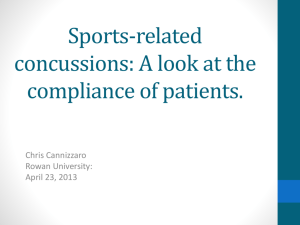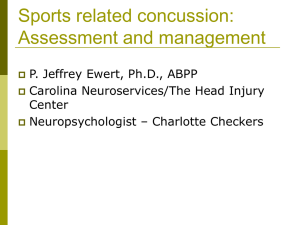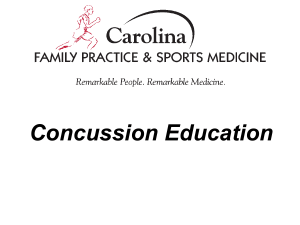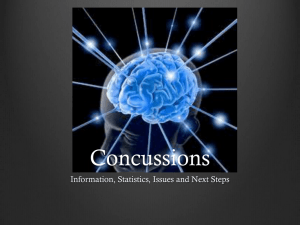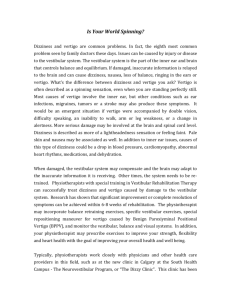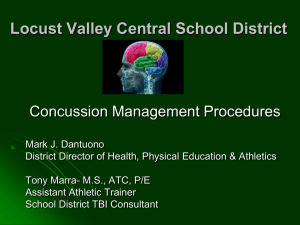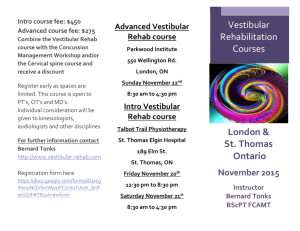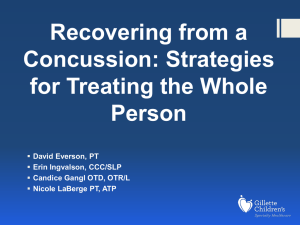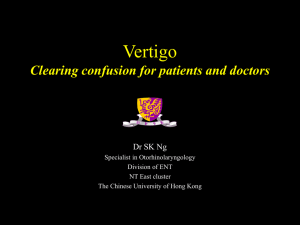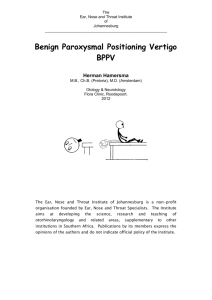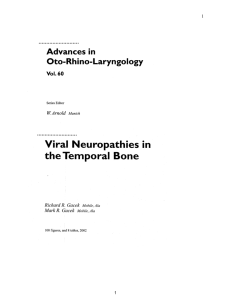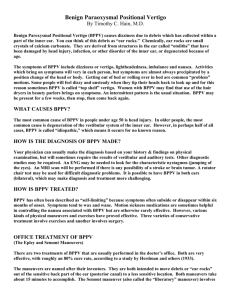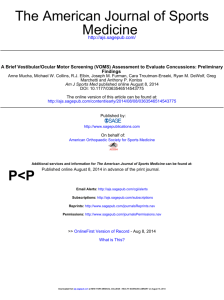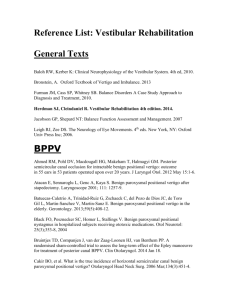Presentation title Times New Roman Bold 45/48 points
advertisement
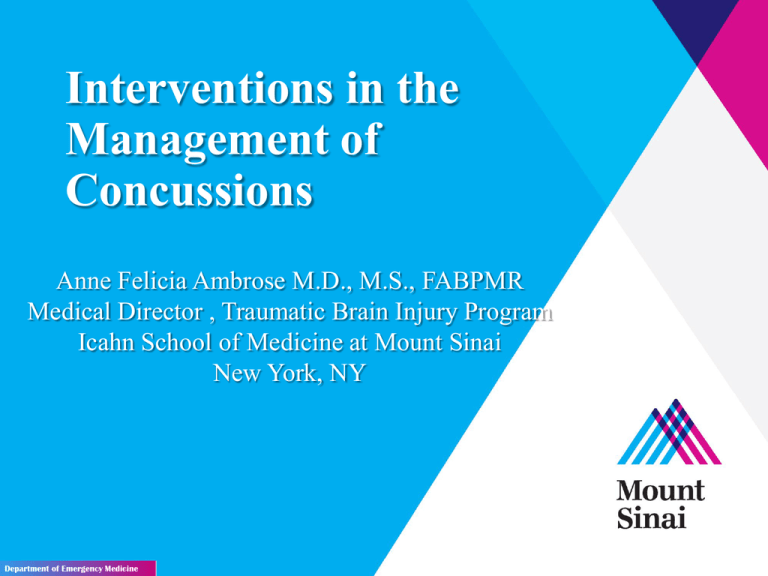
Interventions in the Management of Concussions Anne Felicia Ambrose M.D., M.S., FABPMR Medical Director , Traumatic Brain Injury Program Icahn School of Medicine at Mount Sinai New York, NY Department of Emergency Medicine Approach to the Management of Concussion 1. Pre-Injury 1. Create and Implement legal safeguard at state, national, Sporting Body level 2. Changes to the Game-Rules of Play 3. Protective equipment; 4. Pre-injury assessments 2. Injury 1. Assessments-On the sidelines, ED, Doctor’s Office- Screening, Imaging 3. Post Injury Interventions 1. 2. 3. 4. 5. 6. 7. 8. Rest Return to Play Protocol Physical and Occupational Therapy Cognitive and Behavioral Assessments and Therapy Vision Therapy Vestibular Therapy Drug Therapy Retirement Features of sport-related concussion SYMPTOMS/ PH YSICAL SIGNS SLEEP DISTURBANCES COGNITIVE IMPAIRMENT EMOTIONAL/ BEHAVIOURAL CHANGES Loss of consciousness He adache Nausea/V omiting Dizzines s Loss of balance/poor coordination Visual disturbances Phot ophobia Amnesia Decreas ed playing ability Drowsiness Trou ble falling asleep Sleeping more than usual Sleeping less than usual Slowed reaction times Difficulty concentrating Dif ficulty remembering Co nfusion Feeling in a fog Feeling dazed Irritability Emoti onal lability Sadness Anxiety Inapprop riate emotions Basic Principles-Post Injury Interventions 1. Rest-Physical and cognitive rest until asymptomatic 2. Graded program of exertion 3. Additional Evaluations and Interventions 4. Medical clearance 5. Return to play. Department of Rehabilitation Medicine Rest-Physical and Cognitive 1. Collegiate and High School students athletes who RTP on the same day have poorer outcomes Neuropsychological deficits post-injury that may not be evident on the sidelines and are more likely to have delayed onset of symptoms.. 2. Malignant brain edema syndrome-seen rarely, but almost exclusively in young athletes 3. Second Impact Syndrome 4. Young (<18) elite athlete should be treated more conservatively even though the resources may be the same as an older professional athlete Fatigue and Sleep 1. Incidence 2. Clinical features 3. Associative factors -Pain, Pain meds, Females, Depression, Anxiety, time from injury 4. Association with cognition-slower in attentional tasks 5. Sleep disturbances -Drowsiness. Trouble falling asleep, Insomnia, Hypersomnia 6. Treatment Headaches Investigation CT scans be helpful in ruling out serious bleeding injuries, but cannot diagnose a concussion or headache. Treatment 1. Rest, Avoid second concussion especially in first 10 days 2. Medications a. No medicine that clearly alleviates post concussive headache. b. Regular headache medications may help. c. Preventive medications if not resolved within a month. (SE-increase fatigue, weight, or memory, confusion) especially in athletes with long playing history, prior +/- recent concussions, Apo E Cognitive Impairment 1. Incidence 2. Clinical FeaturesSlowed reaction times, Difficulty concentrating and remembering, Confusion, Feeling in a fog or dazed 3. Cognitive Restructuring Form of brief psychological counseling that consists of education, reassurance, and reattribution of symptoms 4. Cognitive And Behavioral Assessments and Remediations Visual Deficits Approach to Common Vision Deficits Following TBI Deficit Primary Associated Symptom: Treatment Accommodation Constant/intermittent blur Lenses, restorative accommodation training Tear Film Integrity Distorted clarity/gritty sensation, which varies with blinking Eye drops Versional Ocular Motility Slower, less accurate reading /difficulty sustaining gaze, shifting gaze, or tracking targets Basic scanning and searching exercises Typoscopic approach Constant/intermittent eyestrain / Vergence Ocular diplopia eliminated with monocular Motility occlusion Fusional prism,;Varying degrees of occlusion ; Vergence stabilizing exercises Approach to Common Vision Deficits Following TBI Deficit Primary Associated Symptom: Treatment VisualVestibular Interaction Disequilibrium exacerbated in multiply, visually-stimulating environments Adaptive exercises using graded provocations.correct accommodation Light-Dark Adaptation Elevated light sensitivity Tinted lenses Visual Field Integrity Missing a portion of vision Yoked or spotted prisms, mirrors, and field expanding lenses ,scanning strategies and compensatory/ adaptation approaches Visual processing Slower speed/impaired visual memory and visual-spatial processing Adaptive and restorative exercises Nausea/Dizziness/Vertigo/Loss of Balance Causes of dizziness, Impaired balance or vertigo 1. Benign paroxysmal positional vertigo (BPPV), 2. Labyrinthine concussion, 3. Perilymphatic fistula (PLF), 4. Post-traumatic Meniere Syndrome (hydrops), 5. Temporal bone fracture, 6. Cervical (cervicogenic) vertigo, 7. Epileptic vertigo, 8. Migraine associated vertigo and ocular motor abnormalities. Symptoms of Post-concussive Vestibular And Balance Dysfunction 1. Dizziness (55–78%), 2. Impaired Balance (43–56%), 3. Blurred Vision Or Diplopia (49%) (Lovell, 2009). Approach to Treatment of Vestibular Dysfunction 1. Rest 2. Evaluation if symptoms persist >2 weeks 3. Medications-avoid meclizine, Aspirin 4. Assessments 1. 2. 3. 4. 5. Detailed history of concussion occurred, Initial presenting symptoms, New or existing medications, Prior history of concussions, or any past imaging or treatment. Clinical diagnostic tools are used to determine the severity of the symptoms to identify potential structural lesions. 1. 2. Balance Error Scoring System (BESS) test, computerized dynamic posturography (CDP) which includes balance tests, the Sensory Organization Test, and visual tracking technologies (Lovell, 2009) Type and purpose Theoretical description Example Canalith repositioning maneuver (Curative for BPPV) Diagnostic and therapeutic Repetitive head movements maneuvers simple and effective for BPPV Habituation (For impaired motion sensitivity) Provocation of stimuli induces symptoms; enhances vestibular compensation; requires repetition; intensity of exercise proportional to severity of symptoms Head position or movement inducing dizziness or vertigo Adaptation (For impairments in convergence) Enhancement of intact vestibular circuits to compensate for loss of function within same system; Use of retinal slip during head movement (verticle or horizontal) Instructed to move head while maintaining focus on moving (VOR1) or stationary (VOR2) target. Degree of difficulty of exercise increased progressively Type and purpose Theoretical description Example Substitution (For major vestibular impairment) Exercises that facilitate preprogrammed eye movements to scan field and detect target in order to prompt head and neck movements to override vestibular-ocular reflex Replacement of deficient vestibular system by enhancement of ocular systems Balance exercises Positional Exercises (To enhance supportive balance systems) Proprioceptive Neuromuscular Facilitation Static balance = alternating visual and somatosensory input, with change of support base-> Wide vs Narrow Aerobic exercise (To strengthen balance via muscle conditioning) Progressive walking exercise with increase time and intensity. Advance gradually to sustained aerobic activity. Promotes strengthening of muscle groups to help improve balance reaction time Dynamic balance = higher level of challenge. Head turning while walking; quick head turn (right or left) while walking; incorporating task while walking-> tossing an object or cognitive task while walking Pharmacological therapy in sports concussion 1. Role of pharmacological approach 1. Management of specific prolonged symptoms (e.g. sleep disturbance, anxiety etc..). 2. Modify the underlying pathophysiology of the condition with the aim of shortening the duration of the concussion symptoms. 2. An important consideration in RTP is that concussed athletes should not only be symptom free but also should not be taking any pharmacological agents/medications that may mask or modify the symptoms of concussion. 3. Where antidepressant therapy may be commenced during the management of a concussion, the decision to return to play while still on such medication must be considered carefully by the treating clinician. Retirement 1. Professional athletes with a history of multiple concussions and subjective persistent neurobehavioral impairments 2. Counseling. about the risk factors for developing permanent or lasting neurobehavioral or cognitive impairments and should recommend retirement from the contact sport to minimize risk for and severity of chronic neurobehavioral impairments Play Safe Program at Mount Sinai Athletic Coaches, School Nurses, Parents Emergency Departments, Pediatricians, Sports Doctors PLAY SAFE PROGRAM Physical /Occupational/Vision/Vestibular therapy Neurology/Neurosurgery/Orthopedics/ENT/Ophthalmology anne.ambrose@mssm.edu

